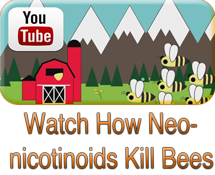11 February 2015 Chronic exposure to neonicotinoids increases neuronal vulnerability to mitochondrial dysfunction in the bumblebee (Bombus terrestris)
11 February 2015 Chronic exposure to neonicotinoids increases neuronal vulnerability to mitochondrial dysfunction in the bumblebee (Bombus terrestris)
This very interesting study indicates that, at only 1/10th the concentration of clothianidin bumblebees are exposed to in the field, effects can be proven on the functioning of bumblebees' brain mitochrondria. Those are essential to the energy supply of their brain.
Fruthermore, at the dose encountered in fields, imidacloprid and clothianidin hamper the development of bumble bee colonies.
The article is not in open access. Hereunder, the abstract:
The global decline in the abundance and diversity of insect pollinators could result from habitat loss, disease, and pesticide exposure. The contribution of the neonicotinoid insecticides (e.g., clothianidin and imidacloprid) to this decline is controversial, and key to understanding their risk is whether the astonishingly low levels found in the nectar and pollen of plants is sufficient to deliver neuroactive levels to their site of action: the bee brain. Here we show that bumblebees (Bombusterrestris audax) fed field levels [10 nM, 2.1 ppb (w/w)] of neonicotinoid accumulate between 4 and 10 nM in their brains within 3 days. Acute (minutes) exposure of cultured neurons to 10 nM clothianidin, but not imidacloprid, causes a nicotinic acetylcholine receptor-dependent rapid mitochondrial depolarization. However, a chronic (2 days) exposure to 1 nM imidacloprid leads to a receptor-dependent increased sensitivity to a normally innocuous level of acetylcholine, which now also causes rapid mitochondrial depolarization in neurons. Finally, colonies exposed to this level of imidacloprid show deficits in colony growth and nest condition compared with untreated colonies. These findings provide a mechanistic explanation for the poor navigation and foraging observed in neonicotinoid treated bumblebee colonies.

